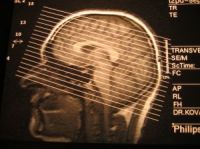Article
High Rates of Neuroimaging in Outpatient Headache Visits
Author(s):
Despite current guideline recommendations against the use of routine neuroimaging for uncomplicated headaches, physicians still tend to order imaging tests for many patients who present with headache and migraine, driving up annual healthcare spending.

Lead author, Brian Callaghan, MD, assistant professor of neurology at the University of Michigan, presented findings from a study that looked at the high utilization of neuroimaging for patients with headaches yesterday during a poster session at the 2013 Annual Meeting of the American Neurological Association. The study was supported by an ADA Junior Faculty Award.
Guidelines from the American Academy of Neurology, the European Federation of Neurological Societies, and the American College of Radiology all recommend against routine neuroimaging for uncomplicated headaches. These include migraines and chronic headaches without risk factors for intracranial pathology such as focal neurological signs or headache occurring after trauma. In patients with such chronic headaches, CT and MRI reveal significant abnormalities in only 1-3% of patients.
The authors of the present study sought to describe the use of neuroimaging in outpatient headache visits. Callaghan and colleagues used data from the 2007-2010 National Ambulatory Medical Care Survey (NAMCS), a nationally representative survey, to estimate neuroimaging utilization in US adult outpatient headache visits (as defined by the ICD-9 and reason for visit codes). Using multivariable logistic regression, the researchers examined the associations between patient factors and neuroimaging use.
Neuroimaging took place as a result of 12.4% of these 50.3 million visits for any headache type (10.5%-14.7%, CI: 95%). This accounted for health care costs of $975 million dollars annually. Patients with migraines had somewhat lower utilization at 9.8% (7.4-12.9%, CI: 95%), but these numbers are still quite high given that current guidelines recommend against imaging in most such patients. Neuroimaging costs for migraines accounted for about $382 million dollars annually.
These numbers dropped only slightly for patients who had no risk factors for intracranial pathology. Neuroimaging still took place in 12.0% of these visits (9.9-14.5%, CI:95%). In patients with migraines who had none of these risk factors, the rate only dropped to 8.6% (6.2-11.8%, CI:95%). Neuroimaging rates did not increase in patients who had risk factors for intracranial pathology (OR = 1.0, 0.6-1.6, CI: 95%).
These study results reveal that neuroimaging occurs in a substantial number of office visits, many more than are advised under current guidelines. The researchers noted that bringing management more in line with current guidelines could substantially reduce these costs. Initiatives like the Choose Wisely campaign (sponsored by the American Board of Internal Medicine) encourage both patients and physicians to question the use of possibly unnecessary tests such as neuroimaging for uncomplicated headaches.
The study authors believe that patient reassurance is the number-one reason that physicians order many of these unnecessary tests. Future interventions might focus on educating patients about the low yield of such tests, the probability of false positive results, and test costs. A value-based insurance design (with patients paying more for unnecessary tests) also might help decrease overuse.



